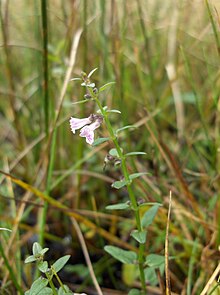
Anemonoides nemorosa, the wood anemone, is an early-spring flowering plant in the buttercup family Ranunculaceae, native to Europe. Other common names include windflower, European thimbleweed, and smell fox, an allusion to the musky smell of the leaves. It is a perennial herbaceous plant growing 5–15 cm (2–6 in) tall.

Myrrhis odorata, with common names cicely, sweet cicely, myrrh, garden myrrh, and sweet chervil, is a herbaceous perennial plant belonging to the celery family Apiaceae. It is the only species in the genus Myrrhis.
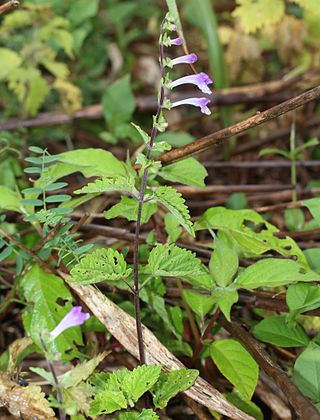
Scutellaria is a genus of flowering plants in the mint family, Lamiaceae. They are known commonly as skullcaps. The generic name is derived from the Latin scutella, meaning "a small dish, tray or platter", or "little dish", referring to the shape of the calyx. The common name alludes to the resemblance of the same structure to "miniature medieval helmets". The genus has a subcosmopolitan distribution, with species occurring nearly worldwide, mainly in temperate regions.
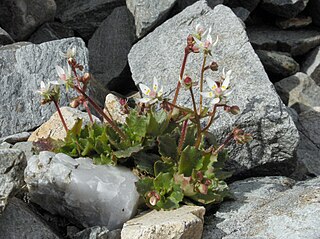
Micranthes stellaris, synonym Saxifraga stellaris, the starry saxifrage or hairy kidney-wort, is an Arctic–alpine species in the family Saxifragaceae. It produces panicles of 5–10 white flowers on a stem up to 20 cm (7.9 in) tall, rising from a basal leaf rosette. One subspecies is found from eastern Canada to Russia, including the British Isles, while another is found in the mountains of southern Europe.

Silene dioica, known as red campion and red catchfly, is a herbaceous flowering plant in the family Caryophyllaceae, native throughout central, western and northern Europe, and locally in southern Europe. It has been introduced in Iceland, Canada, the US, and Argentina.

Draba aizoides is a species of flowering plant in the family Brassicaceae, known as yellow whitlow-grass. It is native to Europe where it is found on limestone rocks and walls. In the British Isles it is found only on the Gower Peninsula in Wales.
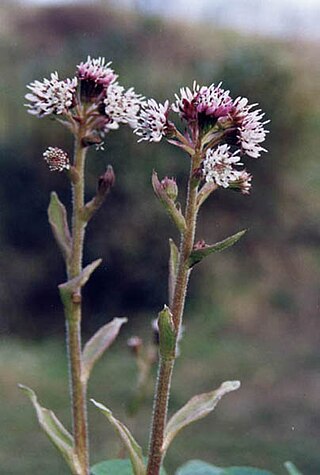
Petasites pyrenaicus, the winter heliotrope, is a medicinal and ornamental flowering plant in the family Asteraceae.
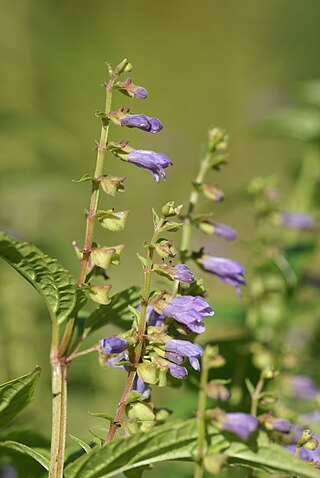
Scutellaria lateriflora, is a hardy perennial herb of the mint family, Lamiaceae, native to North America.

Scutellaria galericulata, the common skullcap, marsh skullcap or hooded skullcap, is a hardy perennial herb native to northern areas of the Northern Hemisphere, including Europe, Asia, and almost all of Canada. It is a member of the mint family. The form is upright and is usually 20-45 centimeters in height, sometimes reaching up to 80 cm. It is a wetland-loving species and grows along fens and shorelines. The blue flowers are 1 to 2 centimeters long. The flowers are in pairs and are all on the same side of the stem. The flowers do not appear at the top of the stem.

Selaginella selaginoides is a non-flowering plant of the spikemoss genus Selaginella with a wide distribution around the Northern Hemisphere. It resembles a moss in appearance but is a vascular plant belonging to the division Lycopodiophyta. It has a number of common names including lesser clubmoss, club spikemoss, northern spikemoss, low spikemoss and prickly mountain-moss. This plant has one close relative, Selaginella deflexa, native to Hawaii. These two plants form a small clade that is sister to all other Selaginella species.

Equisetum variegatum, commonly known as variegated horsetail or variegated scouring rush, is a species of vascular plant in the horsetail family Equisetaceae. It is native to the Northern Hemisphere where it has a circumpolar distribution.

Asplenium trichomanes, the maidenhair spleenwort, is a small fern in the spleenwort genus Asplenium. It is a widespread and common species, occurring almost worldwide in a variety of rocky habitats. It is a variable fern with several subspecies.

Scutellaria incana, the hoary skullcap or downy skullcap, is a species of perennial flowering plant in the mint family Lamiaceae. It is native to North America and is primarily found in the eastern United States as well as some parts of the Midwest.

Scutellaria antirrhinoides is a species of flowering plant in the mint family known by the common names nose skullcap and snapdragon skullcap. It is native to the western United States, where it grows in forests, woodlands, and open, rocky habitat types. It is a perennial herb producing an erect stem or cluster of stems up to 35 centimeters tall from a system of thin rhizomes. The stems are coated in short hairs which are curled or angled upward and sometimes have resin glands. The oval leaves are coated in tiny hairs and are oppositely arranged. The lowest leaves are borne on short petioles. Flowers emerge from the leaf axils. Each flower is held in a calyx of sepals with a large ridge or appendage on the upper part. The corolla measures up to 2 cm long, tubular in shape with a large upper and lower lip. The upper lip is folded into a beaklike protrusion and the lower has three flat lobes. The corolla is purple to blue with an area of white mottling on the lower lip.
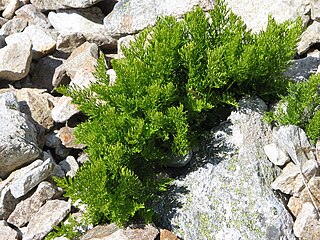
Cryptogramma crispa, the parsley fern, is an Arctic–alpine species of fern. It produces separate sterile and fertile fronds, up to 30 cm (12 in) tall, and is a pioneer species on acidic screes.

Carex spicata is a species of sedge in the genus Carex.

Vicia orobus is a species of leguminous plant in the genus Vicia, known as wood bitter-vetch. It is found in Atlantic areas of Europe, especially in the rocky edges of seasonally-grazed fields. It grows up to 60 cm (24 in) tall, and has no tendrils at the ends of its pinnate leaves. Its flowers are white with purple veins, and are borne in groups of 6 or more.

Doronicum pardaliances, known as leopard's-bane, is a species of flowering plant in the family Asteraceae. Like other members of the genus Doronicum, it is a rhizomatous herbaceous perennial. It has upright stems growing to 80 cm (31 in), with heart-shaped basal leaves and yellow flowers, generally 3–4 cm (1.2–1.6 in) across. It is native to western Europe and was introduced to the British Isles, where it was first recorded in Northumberland in 1633.

Dryopteris aemula, the hay-scented buckler-fern or hay-scented fern, is a species of perennial leptosporangiate fern.

Stellaria alsine, the bog stitchwort, is a species of herbaceous perennial flowering plant in the carnation family Caryophyllaceae. It grows in bogs and marshes in Europe and parts of North America.
